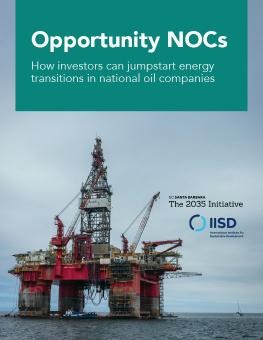
Opportunity NOCs
How investors can jumpstart energy transitions in national oil companies
National oil companies (or NOCs) like Saudi Aramco and Russia’s Gazprom produce half of the world’s oil and gas, control two-thirds of global reserves, and serve as political giants in their home economies. This means that they will play a crucial role in the success or failure of the energy transition. Investors are financially exposed to NOC risks, but this exposure opens avenues for investor influence on NOCs and creates a strong incentive for investors to use such influence. If the world is to meet the goals of the Paris Agreement, NOCs must begin decarbonizing their activities.
In spite of constituting half of the world’s oil and gas production and controlling two-thirds of global reserves, national oil companies (or NOCs) receive a lot less attention than international oil companies (IOCs) from investors, regulators, and the broader public to reduce greenhouse gas emissions and accelerate the transition to clean energy. If the world is to meet the goals of the Paris Agreement, NOCs must begin decarbonizing their activities.
Despite the seemingly closed-off nature of many NOCs, both the extent of investor exposure and the degree of investors’ potential influence over the fates of NOCs are far greater than investors themselves may perceive. For example, Russia’s 2022 invasion of Ukraine showcased just how exposed investors are to geopolitical risks borne by state-owned Rosneft and Gazprom, with the latter suspended from trading on the London Stock Exchange in March 2022.
Investors are financially exposed to a range of NOC activities. For example, some NOCs can be partly shareholder-owned like Equinor and Petrobras. Others have issued bonds like Pemex and the Abu Dhabi National Oil Company. Last, a number of NOCs require outside technical assistance and financing, especially on frontier oil and gas projects. In addition, investors are exposed to NOCs through their holdings in banks like JPMorgan Chase, Citi and Bank of America, which have financed hundreds of billions of dollars per year to the largest NOCs. This exposure both opens avenues for investor influence and creates a strong incentive for investors to use it.
We encourage investors to take some immediate steps to encourage NOCs to start decarbonizing their activities, and contextually reduce investors’ own exposure risk to NOCs:
- Direct NOCs to adhere to climate disclosure requirements to improve their transparency and prevent offshoring of emissions by IOCs to NOCs.
- Develop and apply ESG frameworks to NOCs similar to those increasingly applied to IOCs to reveal the myriad risks faced by investors, financial actors, and operational firms partnering with NOCs.
- Call on banks to refrain from financing new oil and gas expansion projects by NOCs.
Participating experts
You might also be interested in
Toolkit for Monitoring, Evaluation, and Learning for National Adaptation Plan Processes
This toolkit provides practical guidance for the development and continuous improvement of MEL systems for national adaptation plan processes to government teams and practitioners working on adaptation.
ASGM Tailings Management and Reprocessing Governance
This report outlines technical aspects, governance frameworks, and policy recommendations for artisanal and small-scale gold mining (ASGM) tailings management and reprocessing.
A Scan of Natural Infrastructure Approaches
A scan of communities in Canada that are successfully implementing natural infrastructure to help deliver municipal services.
Climate Adaptation and Protected Areas Initiative: Nature-based solutions for climate adaptation (infographic)
Climate change impacts greatly affect ecosystems and the communities who depend on them. Nature-based solutions for adaptation (NbS) can play a vital role in helping people and biodiversity build resilience to climate risks. Learn more about what effective NbS for adaptation are and their practical application across different ecosystems to strengthen their resilience.